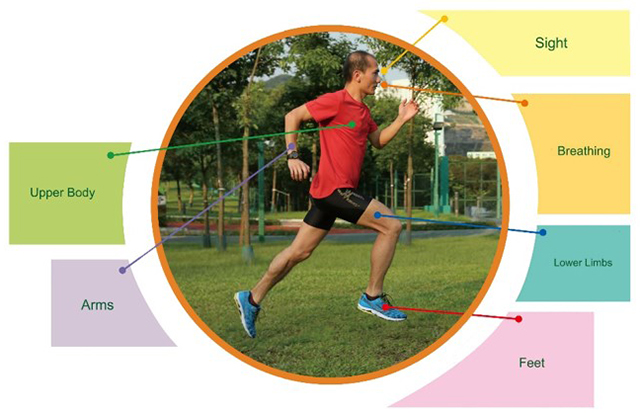 Leisure and Cultural Services Department - Healthy Exercise for All CampaignLeisure and Cultural Services Department
Leisure and Cultural Services Department - Healthy Exercise for All CampaignLeisure and Cultural Services Department
Running for Health

C Running Practice
1.Running Posture
Keep your upper body upright naturally when running, and avoid being too rigid or bending backward. Your arms should relax and swing rhythmically. You should also relax your upper body with shoulders facing forward and swing your arms naturally. Your foot should land on the ground in a light and natural manner.
To prevent sport injury caused by strain, you should wear light and comfortable sports shoes with good shock absorption.
| Upper Body: | Relax your upper body with shoulders facing forward and feel the central axis of your body. Keep your waist, abdomen and shoulders stable. |
| Arms: | Keep your elbows at an angle of about 90 degrees. Your arms should swing from back to front naturally and rhythmically. |
| Lower Limbs: | Follow the swinging rhythm of your arms and keep a natural stride pattern. |
| Feet: | Land on the ground with the entire foot. Make use of the reaction force absorbed at feet to push your body forward through your leg and waist. |
| Sight: | Focus on a point 50-60 meters in front (do not lift your chin or your body will become too rigid or bend backward). |
| Breathing: | Beginners should be relaxed and breathe in a natural rhythm, while advanced runners may breathe steadily in rhythm with their running pace. |

2. Breathing
Breathe in rhythm, preferably in rhythm with your running pace.
- Breathe in rhythm, preferably with your running pace.
- Breathe in rhythm , but need not insist on sticking to a certain frequency. When feeling more oxygen is needed, you will breathe in an accelerated rate automatically. However, you should maintain an appropriate depth of exhalation and a steady breathing rhythm. Inhale with your mouth and nose at the same time and exhale naturally.
3. Training Method: Fixed time-distance running
Running for a fixed distance within a fixed time in a park or on a jogging trail can effectively improve your specific run-endurance and your control of the running pace. Run rhythmically in a relaxed but energetic manner. The intensity of a run should be set according to your physical ability and objectives of training. The duration, distance and intensity of your training may gradually increase depending on your physical conditions.
4. Cool-down Exercise
Do not stop immediately after running. You should continue walking or jogging for 3 to 5 minutes to lower the intensity of exercise gradually until your cardiovascular system is able to adapt. After that, you may stop and rest. In addition, as your muscles will become tense after running, you should do some cool-down exercises in a relaxed rhythm to maintain smooth blood circulation and get rid of the lactic acid to prevent muscle sore. Breathe deeply and walk slowly until you can breathe smoothly. After then, do some stretching exercises for 5 to 10 minutes to enhance the flexibility of your muscles to round up this single training session.


